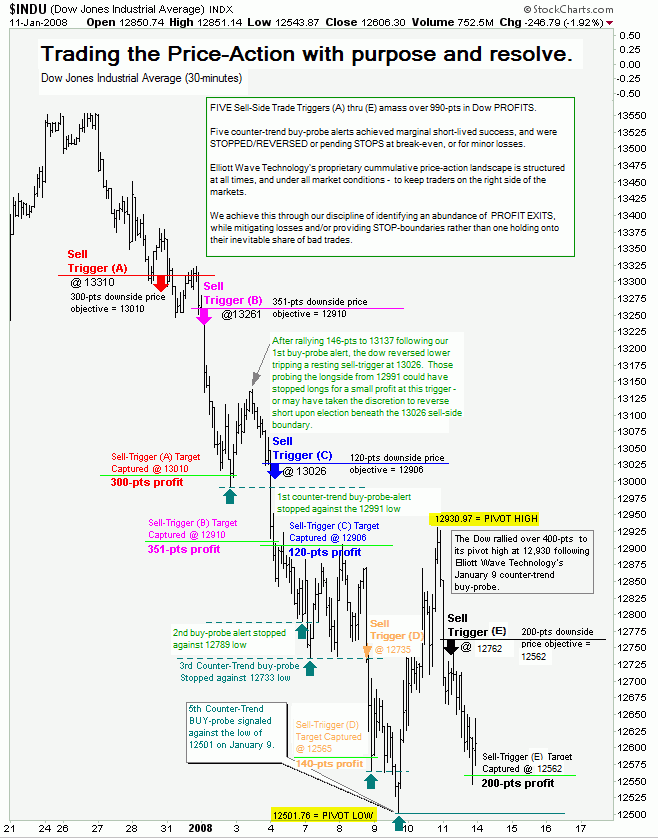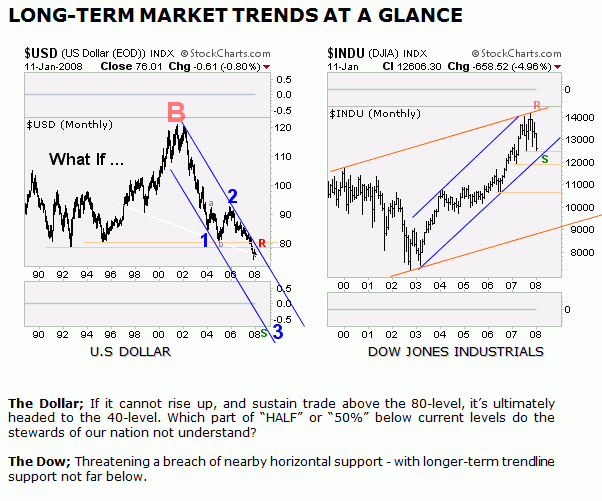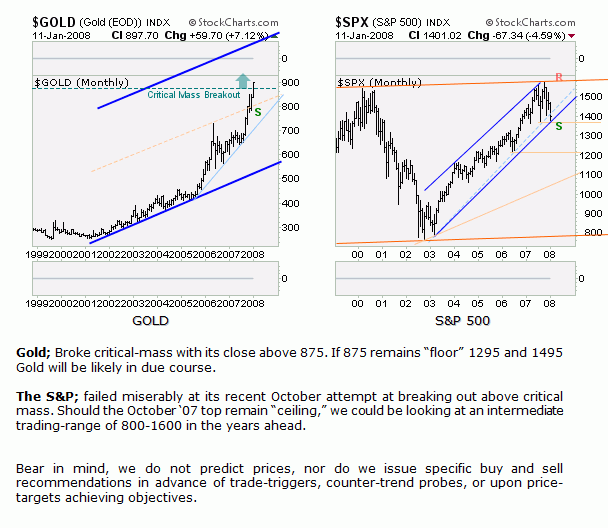Trading the Price Action With Purpose and Resolve
InvestorEducation / Learn to Trade Jan 13, 2008 - 09:07 AM GMTBy: Joseph_Russo
 The following exchange is a brief and rather illuminating excerpt from Jack Schwager's interview with Paul Tudor Jones from the 1990 national best-seller Market Wizards ( Interviews with top traders .)
The following exchange is a brief and rather illuminating excerpt from Jack Schwager's interview with Paul Tudor Jones from the 1990 national best-seller Market Wizards ( Interviews with top traders .)
Jack Schwager: My impression is that you often implement positions near market turns. Sometimes your precision has been uncanny. What is it about your decision-making process that allows you to get in so close to the turns?
Paul Tudor Jones: I have very strong view of the long-run direction of all markets. I also have a very short-term horizon for pain. As a result, frequently, I may try repeated trades from the long side over a period of weeks in a market which continues to move lower.
Jack Schwager: Is it a matter of doing a series of probes until you finally hit it?
Paul Tudor Jones: Exactly- I consider myself a premier market opportunist. That means I develop an idea on the market and pursue it from a very-low-risk standpoint until I have repeatedly been proven wrong, or until I change my viewpoint.
Jack Schwager: In other words, it makes a better story to say, “Paul Tudor Jones buys the T-bond market 2 ticks from the low,” rather than “On his fifth try, Paul Jones buys the T-bond market 2 ticks from its low.”
Paul Tudor Jones: I think that is certainly part of it. The other part is that I have always been a swing trader, meaning that I believe the very best money is to be made at the market turns. Everyone says you get killed trying to pick tops and bottoms and you make all the money by catching the trends in the middle. Well, for twelve years, I have often been missing the meat in the middle, but I have caught a lot of bottoms and tops.
If you are a trend follower trying to catch the profits in the middle of a move, you have to use very wide stops. I'm not comfortable doing that. Also, markets trend only about 15 percent of the time; the rest of the time they move sideways.
We highly recommend reading the rest of Jack's interview with Paul Tudor Jones, along with the balance of in-depth interviews presented throughout this eye-opening book.
In our view, it is apparent that in the above excerpt, Mr. Jones counter-trend “swing-trading” preference relative to “trend-trading,” is no doubt speaking to those seeking to hold positions for longer-durations, and attempting to capture sustained price-moves. In the case of trend-traders, nirvana would be to “let profits run” into perpetuity if a market so permitted.
By definition, “swing-trading” seeks to counter-trade , or fade key pivotal tops and bottoms with a low-risk entry strategy, which intends through a series of probes, to obtain a most favorable entry point of an imminently anticipated price move.
As Paul Tudor Jones succinctly points out above, counter-trend probe efforts are not magical, but rather the result of carefully managed campaigns involving a series of attempts at catching “turns” that are significant and meaningful to one's risk/reward profile.
We will now explore a tactical strategy not discussed in the above excerpt. This is a proprietary strategy which bridges the elemental gap argued by Mr. Jones, and speaks to a level of time-horizon strategy beneath that of “swing-trading.”
We refer to the methodology as price-action “trigger-trading.” Through a series of proprietary buy and sell triggers, Elliott Wave Technology's short-term trading strategy intends to capture fast, short-term profits in as little as one to five-days or more.
You will not see anything like this strategy advertised on late night TV as a means by which to sit by the pool at your well-manicured estate as you trade your way to riches using an easily programmed, color-coded moving average cross-over system. In fact, our methodology can only be attained via a daily adaptive hands-on calibration effort. To our knowledge, our methods are not “programmable,” nor can they be simulated by any form of complex quantative, or black-box analysis.
Our approach is a hybrid - somewhere between scalping/day trading, and classic swing-trading. Another way to categorize this approach would be to call it high-probability, short-term opportunistic speculation.
The analysis presented is clear, orderly, well documented, and archived for retrieval. It is concise, consistent, and apart from counter-trend “probe-alerts” vs. proprietary short-term “trade-triggers” - without contradiction. The added beauty of this unique discipline, is that it is purely a function of price-action, and therefore by default, it is delivered completely free of bias.
Elliott Wave Technology's Near Term Outlook is unrivaled in accurately mapping out the price-action landscape for both swing-traders, and shorter-duration speculative trading. We forecast both styles concurrently, as the two - though at times contrasting - complement one another rather significantly.
Laying Out the Price-Action for both Short-Term, and Counter-Trend Swing Trades:
In carefully reviewing our trade-chart summary below, one can clearly see how the price-action triggers consistently lead the way forward. It is only after periods of extreme or sustained overbought/oversold conditions that we begin to monitor the potential efficacy of deploying counter-trend probe campaigns for short and longer-term swing-traders seeking to fade a given move.

The chart above is not an archived, working analysis chart, but rather a simple graphic summary created to reflect the net effect of our ongoing analysis. Note how four of the five ultimately aborted counter-trend buy-probes were stopped with pursuant “sell-triggers,” or at best, at break-even – beneath the level at which each probe was registered against. Notice as well, the markets propensity to “reverse” in attempt to comply at or near each of our identified probes.
Elliott Wave Technology's Speculative Trade and Investment Mantra:
"Who is the judge? The judge is the price-action... Why is it the price-action? Because the price-action decides who wins or loses, not our opponents ... Who is the opponent? They do not exist.... Why don't they exist? Because they are mere dissenting distraction of the price-action we resolve to trade."



Although we graphically identify probe areas, explicit entry-triggers along with point-values and price-target objectives, decisions to place orders and manage trades through fruition are the sole the responsibility of each individual.
Elliott Wave Technology invites you to make your 2008 New Year Trading Resolution a commitment to RESOLVE the markets alongside the guidance provided by the unparalleled accuracy of the Near Term Outlook.
The Near Term Outlook covers the short-term Dow, S&P, and NDX five-days-per-week, and issues near-term updates for the Dollar, Gold, Crude Oil, and the HUI two times per week.
Trade Better / Invest Smarter...
By Joseph Russo
Chief Editor and Technical Analyst
Elliott Wave Technology
Copyright © 2007 Elliott Wave Technology. All Rights Reserved.
Joseph Russo, presently the Publisher and Chief Market analyst for Elliott Wave Technology, has been studying Elliott Wave Theory, and the Technical Analysis of Financial Markets since 1991 and currently maintains active member status in the "Market Technicians Association." Joe continues to expand his body of knowledge through the MTA's accredited CMT program.
Joseph Russo Archive |
© 2005-2022 http://www.MarketOracle.co.uk - The Market Oracle is a FREE Daily Financial Markets Analysis & Forecasting online publication.



